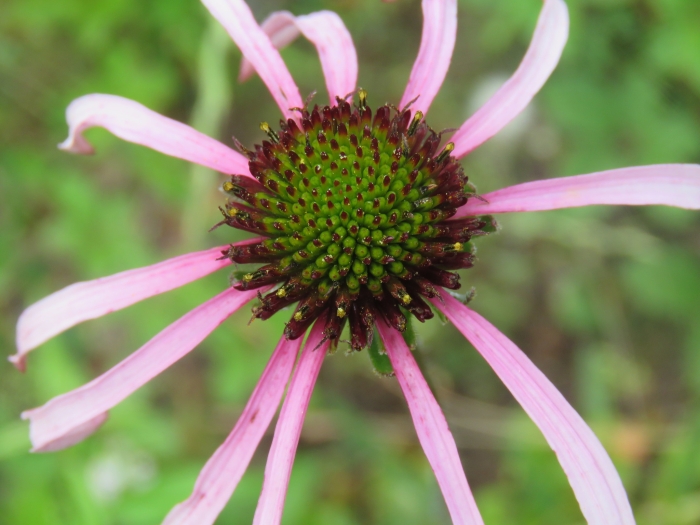Sanguine Purple Coneflower
(Echinacea sanguinea)
Sanguine Purple Coneflower (Echinacea sanguinea)
/
/

Laura Clark
CC BY 4.0
Image By:
Laura Clark
Recorded By:
Copyright:
CC BY 4.0
Copyright Notice:
Photo by: Laura Clark | License Type: CC BY 4.0 | License URL: http://creativecommons.org/licenses/by/4.0/ | Rights Holder: Laura Clark | Publisher: iNaturalist | Date Created: 2016-05-01T14:17:57-07:00 |




















































Estimated Native Range
Summary
Echinacea sanguinea, commonly known as Sanguine Purple Coneflower, is a deciduous perennial herb native to open woodlands, prairies, and savannas in the South Central United States, particularly in Oklahoma and Texas. It typically grows up to 120 cm (3 ft) tall with an unbranched stem. Each stem is topped with a single flower head, featuring ray flowers that range from rose-pink to pale purple and conspicuously droop, surrounding a central cone that is usually orange to brown in color. The flowering season extends from late spring to early summer, and the flowers are known for their showiness and attractiveness to pollinators.
The Sanguine Purple Coneflower is valued for its striking flowers and its ability to attract butterflies and other beneficial insects. It is often used in native plant gardens, perennial borders, and as part of pollinator-friendly landscaping. This species is relatively low-maintenance, requiring full sun and medium amounts of water. It thrives in well-drained soils and is tolerant of drought once established. While it is not commonly afflicted by serious diseases or pests, it can occasionally suffer from aster yellows or powdery mildew. Echinacea sanguinea is not known for aggressive roots or significant invasiveness, making it a good choice for gardeners looking for a reliable and ecologically beneficial perennial.CC BY-SA 4.0
The Sanguine Purple Coneflower is valued for its striking flowers and its ability to attract butterflies and other beneficial insects. It is often used in native plant gardens, perennial borders, and as part of pollinator-friendly landscaping. This species is relatively low-maintenance, requiring full sun and medium amounts of water. It thrives in well-drained soils and is tolerant of drought once established. While it is not commonly afflicted by serious diseases or pests, it can occasionally suffer from aster yellows or powdery mildew. Echinacea sanguinea is not known for aggressive roots or significant invasiveness, making it a good choice for gardeners looking for a reliable and ecologically beneficial perennial.CC BY-SA 4.0
Plant Description
- Plant Type: Herb
- Height: 1-3 feet
- Width: 0.5-1 feet
- Growth Rate: Moderate
- Flower Color: Pink, Purple
- Flowering Season: Summer
- Leaf Retention: Deciduous
Growth Requirements
- Sun: Full Sun
- Water: Medium
- Drainage: Medium
Common Uses
Bee Garden, Bird Garden, Butterfly Garden, Deer Resistant, Drought Tolerant, Hummingbird Garden, Low Maintenance, Rabbit Resistant, Showy Flowers
Natural Habitat
Native to open woodlands, prairies, and savannas in the South Central United States
Other Names
Common Names: Sanguine Purple-Coneflower, Sanguin Purple Coneflower
Scientific Names: , Echinacea sanguinea, Echinacea pallida var. sanguinea,
GBIF Accepted Name: Echinacea sanguinea Nutt.